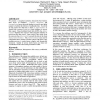KES
2004
Springer
15 years 5 months ago
2004
Springer
When the available information is imperfect, it is often desirable to represent it in the database, so that it can be used to answer queries of interest as much as possible. The da...
107
Voted
GI
2004
Springer
15 years 6 months ago
2004
Springer
: This paper addresses some classical problems to integrate data sources that are heterogeneous in structure with possibly redundant data along a real world example integrating thr...
AUSAI
2004
Springer
15 years 6 months ago
2004
Springer
One problem many Web users encounter is to keep track of changes of distant Web sources. Push services, informing clients about data changes, are frequently not provided by Web ser...
123
click to vote
SIGMOD
2004
ACM
15 years 6 months ago
2004
ACM
An increasing number of data sources now become available on the Web, but often their contents are only accessible through query interfaces. For a domain of interest, there often ...
MUM
2004
ACM
15 years 6 months ago
2004
ACM
We present a conceptual mediation framework that features three layers of mediators: presence, integration, and homogenization layers that work together in a peer-to-peer (p2p) ma...
125
Voted
IQIS
2004
ACM
15 years 6 months ago
2004
ACM
Information integration is often faced with the problem that different data sources represent the same set of the real-world objects, but give conflicting values for specific prop...
106
Voted
WEBDB
2005
Springer
15 years 6 months ago
2005
Springer
Recently, there has been increased interest in the retrieval and integration of hidden Web data with a view to leverage high-quality information available in online databases. Alt...
73
Voted
VLDB
2005
ACM
15 years 6 months ago
2005
ACM
To answer user queries, a data integration system employs a set of semantic mappings between the mediated schema and the schemas of data sources. In dynamic environments sources o...
VLDB
2005
ACM
15 years 6 months ago
2005
ACM
Multi-join queries are the core of any integration service that integrates data from multiple distributed data sources. Due to the large number of data sources and possibly high v...
85
Voted
SEMWEB
2005
Springer
15 years 6 months ago
2005
Springer
The integration of heterogenous data sources is a crucial step for the upcoming semantic web – if existing information is not integrated, where will the data come from that the s...





